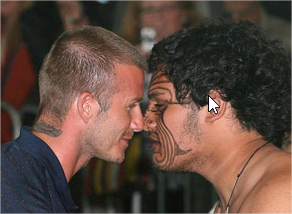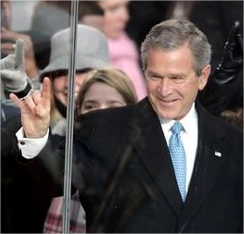5.1: Body Language
- Last updated
- Save as PDF
- Page ID
- 42983
In 2015, the "Boston bomber", Dzhokhar Tsarnaev, was sentenced to death. He and his brother had placed bombs near the finish line of the Boston Marathon, resulting in multiple deaths and injuries. At the trial, his involvement in setting the bombs was not at issue; he admitted his guilt. The question was if he would be sentenced to life in prison or to death. That decision rested with the jury and their perception of Tsarnaev. Character witnesses, family members, and bombing survivors testified. The defense tried to make the case that he was acting under the controlling influence of his older brother. The prosecution portrayed him as a heartless terrorist. A key factor for the jury was to evaluate Tsarnaev's character. His body language during the trial was not helpful to the defense. He seemed uninvolved and bored. He showed no emotional reaction to the horrific scenes and stories from the bombing shown and narrated in court. He didn't look at the jury or make eye contact with those on the witness stand. In mainstream US culture, an averted gaze could be interpreted as an admission of guilt and shame, while the lack of emotional response points to an absence of remorse. The jury was also shown a picture from a surveillance camera in jail in which Tsarnaev held up his middle finger in a gesture of defiance and hostility. The jury also was given the text of tweets Tsarnaev had sent, as well as the anti-US manifesto he had written on the side of the boat where he was captured. The messages no doubt condemned him in the eyes of the jury, but certainly his bearing in court contributed to the jury's ultimate decision. Nonverbal signals rarely decide life or death, but they do play a central role in human communication. In this unit we will be examining how that plays out in cross-cultural communication.

The nature of nonverbal communication
Nonverbal communication can take many different forms and can vary significantly in its manifestations and usage across cultures. Its relation to verbal communication is complex. Verbal language is based on abstract symbols, arbitrarily designated to represent objects or concepts. There's no inherent, logical connection between "cat" or (or the German Katze or Chinese猫) and the feline animal. We learn the significance of the symbols over time. In contrast, much of nonverbal communication involves signs or signals that are natural and often involuntary. Smiling or frowning, for example, are not learned behaviors but naturally occurring human actions. This is not the case for on all nonverbal communication; gestures for greetings or insults, for example, are symbolic and cultural. Verbal language can be analyzed and described by a set of rules. For nonverbal communication there are unwritten rules and conventions but no formal grammar or syntax. The rules for nonverbal communication are learned informally through socialization.
Gestures or facial expressions can send messages independent of language. In fact, in some contexts, those messages (i.e., anger, joy) can be transmitted more effectively by nonverbal means. That includes vocal qualities, such as the tone of voice or actions such as crying or laughing. Often nonverbal communication accompanies speech. In such cases, the relationship between the two can vary. Body language can reinforce or emphasize the verbal message – smiling, for example, while complementing someone. Gestures can also substitute for speech – nodding or shaking the head for yes or no. On occasion, nonverbal gestures might repeat verbal messages, as in giving directions, through pointing to the way to go.

Sometimes, a person's nonverbal message might contradict what is said. A person appearing downcast might respond "Oh, nothing," in response to the question "What's the matter?", but the body language may send a different signal. In such situations, the nonverbal action is likely to be perceived as the authentic message, not the stock verbal response. Nonverbal communication is seen as more honest and revealing in that it is often instinctive and unconscious. Recent research in nonverbal communication (Montepare 2003; Patterson, 2003) has demonstrated that some nonverbal behaviors fulfill universal human social needs and contribute to social cohesion and bonding. Widely used nonverbal behaviors can help identify in-group membership.
It is likely that most individuals would be surprised to learn how important nonverbal behavior is in conveying messages during conversations. The common perception is that what we are mostly paying attention to are the words being said. We tend to be unaware of the many other factors that can impact the nature of a verbal interaction. The relative importance of nonverbal codes varies with context and culture, but some estimates of what weight is conveyed by nonverbal versus verbal means gives a much higher percentage to nonverbal. Albert Mehrabian (1971) asserted that we develop our attitude towards the other person (like or dislike) overwhelmingly through nonverbal means. In fact, he claimed that 93% of that process happens nonverbally, through vocal tone and gestures (38% and 55% respectively), rather than through the literal meaning of the words (7%). The important role that nonverbals play in communicating across cultures is demonstrated in the fact that the study of intercultural communication originated with investigations into the "silent language" and "hidden dimensions" of time and space in communication (titles of seminal books by Edward Hall, 1959, 1966). One might question Mehrabian's formula as it applies to individual conversations and particular cultures. One can imagine conversations, for example, in a doctor's office or in a school, in which the essence of the communication and the affective impact are carried substantially by language. Given the importance and ubiquity of written digital messaging, contemporary communication is often electronically mediated and occurs with no nonverbal codes, except for emoji or embedded media.
Sending Signals without Words
There are a number of human interactions which occur largely without the use of language or in which language plays a clearly secondary role. That's the case in rituals, a clearly defined set of actions performed on particular occasions and having symbolic significance. Greetings and departures, for example, have rituals that are largely nonverbal, such as shaking hands or waving. These tend to vary across cultures. In Japan, for example, it is common to bow when greeting someone, with the nature of the bow (how deep and how long) being determined by the nature of the occasion and social connection of the persons involved. In some cultures, kissing on the cheek is the usual greeting, although how many times the kisses are exchanged and which sexes are included can vary. In other parts of the world there may be hugs and kisses, depending on the context and relationship. In Arab countries it is common to bow and touch the forehead and chest (the salaam) when meeting someone. The Wai is used in Thailand and in other Asian cultures, consisting of a bow with the palms pressed together. In other cultures, people rub noses, such as in the hongi, a traditional greeting of the Maori people in New Zealand. Knowledge of such rituals can be helpful in avoiding awkwardness in first encounters.


Nonverbal signals come not just from body movements such as handshaking or bowing but also through the presence (or absence) of personal objects or artifacts. Those may be articles of clothing, jewelry or accessories we wear or hold, or might be physical items surrounding us. Signals may be sent by more intangible means such as smell or sound. There may be a complex array of nonverbal factors at play, as in this example of nonverbal behavior at a military checkpoint:
A Sunni driver coming up to a security post he believes is under Shia control should not only have the right ID to hand, but should also push in a tape playing Shia religious songs and turn up the volume. He should hang a picture of Imam Ali, the son-in-law of the Prophet Muhammad and the most revered figure in the Shia faith, from the rear-view mirror. He might also slip on the large silver ring worn only by Shias, especially those considered to be descendants of the Prophet, and perhaps carry a “torba”, the round piece of clay that Shias often place on their foreheads when they bow down in prayer. These and other handy tips are given on the Iraqi Rabita website, designed to advise Sunnis on how to get through Shia checkpoints (Checkpoints, 2007).
The situation is not likely one most of us will ever encounter, but it dramatizes the importance of nonverbal codes in particular contexts. In such situations, nonverbals can play a significant role in easing tensions. On the other hand, inappropriate nonverbal behavior can easily have the opposite effect, exacerbating potential tensions and causing open conflict.
Gestures across Cultures
One of the areas in which there is considerable cultural variation is in the use of gestures and body movements. This area of communication is called kinesics, with the two main kinds of actions labeled emblems and illustrators (Ekman & Frieden, 1969). Emblems are hand gestures that have by themselves a direct meaning, such as insult gestures like the raised middle finger. Illustrators are hand or arm gestures that accompany speech and which accentuate or complement what is said. Pounding a podium with one's fist while giving a speech is an example of an illustrator. Emblems and illustrators are used for a variety of social functions, such as greeting, leave-taking, providing directions/commands, or issuing warnings. Being aware of cultural differences in this area can be important in cross-cultural encounters.
One of the richest array of gestures are for communicating insults and obscenities. Insult gestures tend to vary across cultures and are different as well in the extent to which they are used. In Greece, for example, the mountza (μούντζα) or moutza (μούτζα) is a commonly seen insult gesture. It consists of spreading the fingers (one hand or both) and trusting them outwards, towards the other person (as if flinging something unpleasant). In other cultures, the arm-thrust (bras d'honneur) is used, forging a fist and slapping it upwards under the biceps of the arm. Such gestures can be highly offensive and are often considered obscene. Other gestures may convey skepticism or disbelief, such as the French mon oeil (my eye), using a finger to pull down the lower eyelid. The gesture is also used in Japan, known as the Akanbe (あかんべえ).


The caution in using gestures extends to those which may be widespread in a culture, and which we may interpret as universal. The North American A-OK sign (circled thumb and pointer finger, with the other fingers spread out) is an obscene gesture in many European cultures. Likewise, the inverted peace sign – two fingers facing inwards is an insult in England and Australia. The thumbs-up gesture signals in North America well done; in Greece and other countries, it is equivalent to the insulting "Up yours!" (Cotton, 2013). US President George W. Bush famously used the hook ‘em horns gesture of the Texas Longhorn football team to signal his approval of the marching band of the University of Texas. In Italy, that gesture is well-known, but it doesn't signal fan enthusiasm or let's rock. It is called il cornuto, indicating that the other person is a cuckold, that is, that his wife is cheating on him (Cotton, 2013).
Pointing with the forefinger is a gesture North Americans frequently use. Using that gesture to point at people is in some cultures extremely rude. Likewise, the beckoning gesture with palm turned upward and extending one finger or the whole hand is considered an insult in Japan and other countries. There are a variety of beckoning gestures, In Afghanistan and the Philippines, for example, one motions downward with the palm of the hand facing the ground (Cotton, 2013). Emblems have traditionally been culture-specific. However, the forces of globalization and technology have exposed people worldwide to gestures used in popular media (Matsumoto & Hwang, 2012). Through the greater availability globally of North American television shows and movies, as well as the popularity of social media such as Facebook and YouTube, some North American gestures, such as those for greeting and departure, have become familiar in many other cultures. (Jackson, 2014).


Another kind of gesture is an adaptor, a kinetic action used to satisfy a psychological or physical need, such as tapping one's feet or playing with a pen. Some are learned behaviors, such as covering one's mouth when sneezing, while others, such as scratching, are automatic or biological. Most do not affect communication, as they are not intended to send a message. However, some are considered rude in particular cultures; examples are: "never chew gum in public in France; whistling under any circumstances in India is considered impolite; pointing a finger in the Arab world is considered a rude gesture; and winking may be considered an insult or a sexual proposition in India and Pakistan" (Ting-Tooney, 1999, p. 126). Using adaptors in the wrong context or at the wrong time can be awkward or embarrassing.
The universality of facial expressions
Some cultures tend to be much more expressive and rich in their use of body language than others. Italians and Mediterraneans in general are normally placed in that category, while northern Europeans and Asians are seen as more restrained in their use of gestures. It is often claimed that facial expressions – called affects displays – tend to be universal, the idea being that expressing basic emotions is an elemental, instinctive behavior common to all humans. This idea goes back to Charles Darwin (1872) who claimed all humans express emotion in the same way. This was later contradicted by anthropologists such as Margaret Mead (1975). It wasn't until the 1960s that so-called "universality studies" were conducted by Paul Ekman and others. In a series of experiments involving participants from a variety of cultures, they showed that there were six universal expressions — anger, disgust, fear, sadness, happiness, and surprise (Ekman, 1972). Later, a seventh expression, contempt, was added (Ekman & Heider, 1988). As the studies involved people from industrialized countries, who may have learned to interpret faces from mass media, other studies were conducted among tribal groups in New Guinea, which came to similar results (Ekman & Friesen, 1971). An interesting experiment conducted with blind athletes produced the same results as their sighted colleagues (Matsumoto & Willingham, 2009). Because the blind athletes could not have learned the behaviors, one can assume there is an innate capacity to display facial expressions.

What causes particular emotions and determines their intensity can be quite different, both personally and culturally. It is also the case that in many contexts we are able to assert control over our expressions. Codes of general conduct, politeness, or social harmony may influence the public display of emotions. This was shown in a cross-cultural experiment (Matsumoto & Ekman, 1989), which studied expressions of Japanese and US students while watching emotionally disturbing films. When both groups of young people were among themselves, they showed the same expressions. However, when the Japanese students were with an older, male observer, they displayed neutral expressions or even smiled, while the US students continued to display the same negative emotions. Ekman and Friesen (1969) coined the term cultural display rules to describe such cultural differences in facial expressions. The concept explains the difference in expressions of the Japanese students in the experiment, as due to the cultural mandate in Japan of managing and minimizing expressions of feelings in the presence of a third party. In Japan it is culturally appropriate to hide unhappiness by smiling or embarrassment by laughing. While weeping in public is considered in Japan to be inappropriate, in Middle Eastern or Latin American cultures it is normal to express one's emotions openly and visibly.
Using the concept of cultural display rules, Matsumoto (1990) developed a theory of the expression of emotions that incorporates Hofstede's taxonomies, particularly as they relate to individualism versus collectivism. According to the theory, because individualistic cultures encourage and reward self-expression, individuals in those cultures are free to express fully and instinctively their feelings, whether they be positive or negative. On the other hand, those in collectivistic cultures are bound by conventions of the collective good and social harmony to regulate their expression of emotion when not alone. Matsumoto also incorporates the concept of power distance:
High power-distance cultures endorse displays of emotion that reinforce hierarchical relations (i.e., status reminders), such as showing anger toward a low-status person or appeasing a high-status person (e.g., smiling). Low power-distance cultures embrace egalitarian values and teach the importance of treating people as equals. Thus, there is less pressure in these cultures for members to adjust displays of emotion according to the status of another person. (Remland et al., 2014)
High power distance cultures tend also to be labeled collectivistic; that would include most Middle-Eastern, Latin American, African and southern European countries. Low power/individualistic cultures are considered to be South Africa, North America, Australia, and northern Europe (Hofstede, 1980). As always, in such broad-stroke generalizations, caution is needed in applying these labels to individuals. While dominant cultural forces may be powerful, they may be contradicted and potentially negated by values associated with group membership, whether those be ethnic, regional, or other. It is also the case that individual personalities play a significant role in the degree to which emotions are displayed or suppressed. The patterns we've identified in nonverbal behavior should be seen as examples not as absolutes. Being aware of such potential variations can be helpful in adjusting expectations and suspending judgments.
Personal space
One of the actions which can affect the course of the conversation is for one or the other of the conversants to move closer or further away. Edward Hall (1966) pioneered the study of proxemics, the perception and use of physical space, including territoriality and personal space. Territoriality refers to the actual physical space, while personal space is perceptual or psychological – the kind of space bubble that we perceive around us. Following complaints from both Arab and US students in a North American university setting, O.M. Watson (1970) investigated the nonverbal behavior of the two groups. He found that the US students viewed the Arabs as pushy and rude, while the Arabs considered the US students to be distant and rude. He discovered that a substantial part of the problem were different conceptions of personal space, with the US students feeling the Arab students were invading their bubbles and the Arab students seeing the US students as unfriendly because they were keeping their distance. Hall (1966) developed a four-level classification of social distance. For the US, he defined intimate space, reserved for highly personal relationships, as 9 to 18 inches (23 to 45 cm), and personal distance ("arm's length") at 1.5 to 4 feet (.5 to 1.2 m), the normal spacing for conversations. Social distance he established at between 4 and 12 feet (1.2 to 3.6 m), the spacing normal in casual gathering and work environments. Public distance he defined as being 12 feet (3.6 m) or longer, used for public speaking or large gatherings. Researchers have identified particular cultures as "high contact", meaning that there is a preference for a closer proximity and a high degree of physical contact (Aiello, 1987). Examples frequently given are Arabs, Latin Americans, and southern Europeans, who all tend to use closer interaction distances then in so-called low contact cultures (USA, northern Europe, Australia). There are other factors besides regional culture which may affect personal distance, such as gender, age, ethnicity, or topic of conversation.

Personal distance is sometimes associated with smell. The study of smell in humans is called olfactics. In some cultures (in Africa and the Middle East, for example) there's a preference for standing close enough to a person in conversation to be able to detect body odor. Odor is used in such cases to categorize people according to status, power, or social class. In many cultures wearing an expensive perfume or cologne can signal status and wealth. On the other hand, the smell of sweat or strong body odor is likely to suggest manual labor and lower social status. Some smells are associated with particular ethnic groups and may lead to prejudicial treatment. The smell of curry, linked to South Asians, has been used as a basis for discrimination, such as refusing to rent apartments to Indians or Pakistani (Jackson, 2014). Although some smells seem to be universally attractive (jasmine, lavender, roses) others may vary in how they are perceived across cultures. The smell of onions, for example, is considered unpleasant in many cultures, but the Dagon people of Mali find the smell attractive, even to the point of rubbing onions on their bodies (Neuliep, 2006).

Physically interacting with others
There are also cultural conventions related to if and how the conversation partner should be touched. This area of nonverbal communication, tactile communication or the use of touch, is known as haptics. Touch conventions vary significantly across cultures and are dependent as well on age, gender, and relationship. In some Arab cultures, it is common for men to hold hands in particular situations. Some cultures have a taboo on touching the top of someone's head, as in patting a child, as the head is considered sacred. Another taboo, in India, the Middle East, and Africa, is the use of the left hand in certain social situations, such as eating. Cooper, Calloway-Thomas & Simonds (2007) provide a set of rules in relation to touch in Thai culture:
- Don’t touch anyone’s head for any reason. The head is the most important part of the body. It is the seat of the soul.
- Do not touch a female on any part of her body.
- The feet are considered the “dirtiest” part of the body. They are used only for walking. Thus, it is an insult to rest your feet on someone else’s backrest, such as in the cinema or on a train.
- Women must never touch a monk or his robe. Even in a bus or train, Women cannot sit next to a monk.
- Always accept things with your right hand. The left hand is used to Wash the posterior and is therefore regarded as unclean (p. 138).
Being aware of such taboos in visiting another culture can make seemingly strange behavior understandable and help to avoid embarrassing faux-pas.
Eye contact is often included as a topic within proxemics as it tends to regulate interpersonal distance. Direct eye contact tends to shorten the sense of distance, while an averted gaze increases it. In many cultures, such as in many Asian countries, avoiding eye contact conveys respect. In some situations, making eye contact communicates that one is paying attention. Breaking off eye contact can be a signal of disinterest or even rudeness. Within the US, different ethnic groups have been found to follow different norms in the use of eye contact to regulate conversations. African-Americans maintain eye contact when speaking but avert their gaze when listening, but just the opposite is true for European Americans (LaFrance & Mayo, 1978). This distinction can lead to conflict:
Interethnic expectancy violations exist when African Americans expect the European Americans to look them in the eyes when speaking but instead receive “non-responsiveness” or “indifference” cues. European Americans, on the other hand, may view the direct eye gaze during speaking as “confrontational” or “aggressive” (Ting-Toomey, 1999, p.126).
In both pluralistic societies and in cross-cultural encounters, being mindful of variations in this area is important. Nora Dresser's book, Multicultural Matters (2005), chronicles how Korean-American shopkeepers, who did not make eye contact with their customers, were perceived as disrespectful, something contributing to the open confrontation taking place in US urban centers between some Asians and African-Americans. In some contexts in the US, such as in urban areas among teens and young adults, looking directly at someone can be seen as a provocation, reflected in the term "mad-dogging" (Remland et al., 2015).



